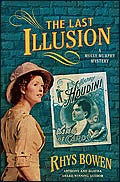The Last Illusion, set in 1903, is #9 in a mystery series about an Irish immigrant in New York who finds herself sole owner of a detective agency after, early in the series, her employer is murdered. Molly is a tall, healthy young woman who eschews corsets and has "doomed" herself "to not being socially acceptable by not being able to produce an attack of the vapors." When she and her policeman fiancé witness a performance by an illusionist opening a show featuring Harry Houdini, that goes gruesomely wrong, Molly retains sufficient presence of mind to calm Houdini's hysterical wife and offer her a business card.
Not yet thirty, Houdini has just returned, flushed with success, from an extensive European tour in which he became known as the "Handcuff King" for his genius as an escape artist. Like all illusionists, he is fiercely protective of the secrets behind his tricks. Fearing a threat to his life, his wife, Bess, hires Molly to discreetly protect him. Time and again, though, Molly is thwarted in her search for evidence. Even Bess refuses to share information that might reveal his methods. Unfortunately, Molly's detective agency is floundering. Bess is her only client. As Molly begins to fear she is in over her head, she must also contend with the protective instincts of her fiancé, who has forbidden her to have anything to do with the Houdini case.
The Last Illusion serves up a clever (though perhaps too multi-faceted) mystery in which Molly's deductions contribute to the solution. Her unlikely exploits as a lady detective are amusing, if not hilariously madcap enough to make their unlikeliness a plus. But the novel also offers a fascinating and believable portrayal of the lives of stage magicians in the early twentieth century, from the masterful Harry Houdini to the vaudeville performers eking out livings at the edge of the law. (2010; 279 pages, including a brief Historical Note)




